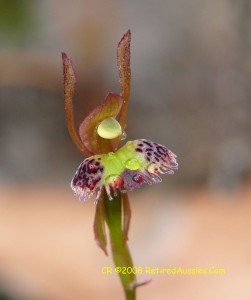Trivia question for May-27-2011
Olivia found another bug to feature in her trivia. This is a group of primitive, medium to large ant species with long, powerful jaws and a venomous sting for catching insect prey.
These ants are well-known in Australia for their aggressive behavior and powerful stings. The venom of these ants has the potential to induce anaphylactic shock in allergic sting victims. As with most severe allergic reactions, if left untreated the reaction may be lethal. These large, alert ants have characteristic large eyes and long, slender mandibles. They have superior vision, able to track and even follow intruders from a distance of 3-feet.
So here are Olivia’s questions: Identify this ant species and tell us what the queen of this species does to determine if the eggs she lays will be male or female. Also, there is a flower that has evolved into a design in the shape of a female of this ant species. Tell us why?
Good Luck 😉
Answer:
Congratulations goes out to Derek Carmichael for being the first one to identify this ant. We featured the Bulldog Ant. These guys are often called bulldog ants, bull ants, inch ants, sergeant ants, jumper ants or jack-jumpers (although jack jumper only applies to members of the M. pilosula species group), is a genus of ants. Bull ants can grow to over 1.6 inches in length, with the smallest species 0.59 in long. Almost all of the approximately 90 species are endemic to Australia, with the single exception of Myrmecia apicalis from New Caledonia, where it is rare.
Myrmecia is one of several ant genera which possess gamergates, female worker ants which are able to mate and reproduce, thus sustaining the colony after the loss of the queen. A colony of Myrmecia pyriformis without queen was collected in 1998 and kept in captivity, during which time the gamergates produced viable workers for three years.

The orchid Leporella fimbriata has evolved a flower design in the shape of a female bulldog ant. Male bulldog ants, deceived by the mimicry, try to mate with the flowers. As they pass from one flower to another, they transfer pollen on their bodies and help pollinate the orchid.
Here is more on these fiery ants: Bulldog Ants
Thanks for playing along 😉

